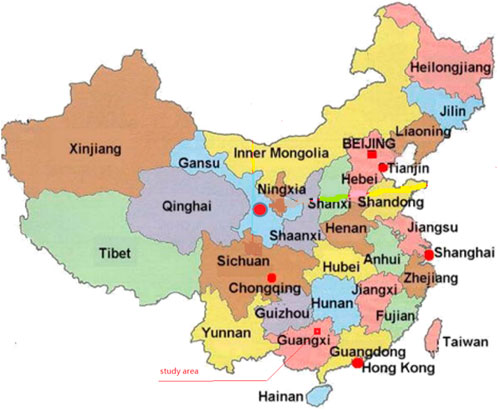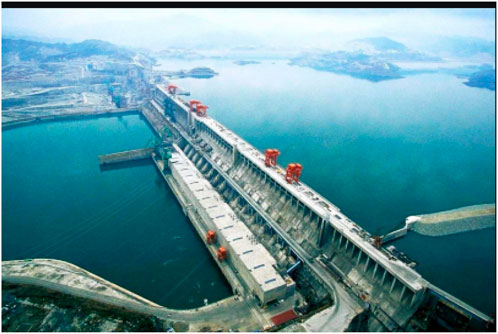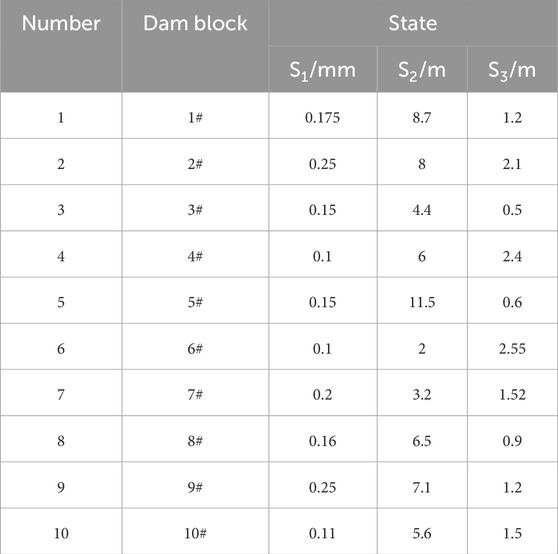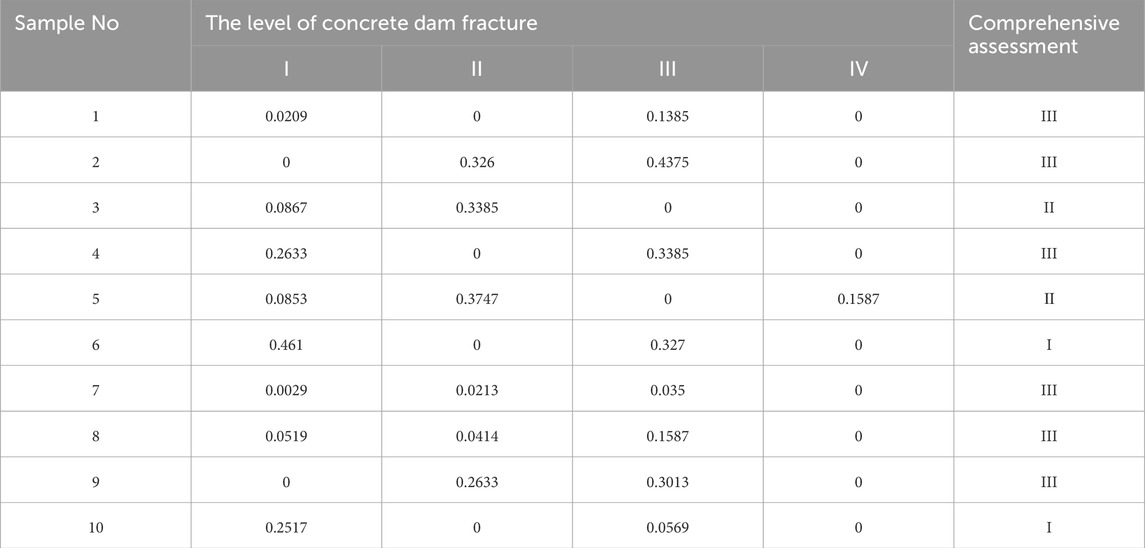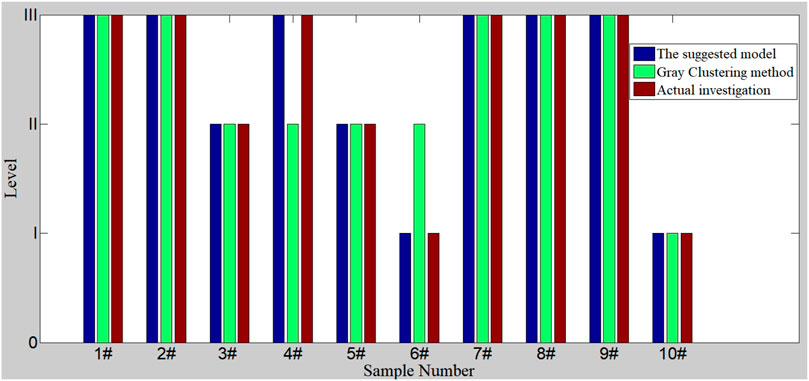- 1School of Architecture, Nanyang Institute of Technology, Nanyang, China
- 2School of Civil Engineering, Nanyang Institute of Technology, Nanyang, China
- 3School of Civil Engineering, Sichuan University of Science and Engineering, Zigong, China
Hazard evaluation of concrete dam fractures is vital for safe operations. The width (S1), length (S2), and depth (S3) of fractures are adopted as the assessment index, and the game theory combination weighting-normal cloud model is introduced. The normal cloud model of certain dam fractures is subsequently established. The weight coefficients of each index are calculated using game theory combination weighting, and the certainty degree of each index is determined using the cloud model. Finally, the hazard levels of the concrete dam fractures are judged. The proposed model solves the fuzziness and randomness of different indexes; the conclusions demonstrate that the model is feasible for the hazard assessment of concrete dam fractures, and its accuracy is very high; therefore, a new approach can be provided for future hazard-level assessments of concrete dam fractures.
1 Introduction
Cracks are common in the operation of concrete dams, and their appearance has become a hidden danger to the safety of dam operations (Gu and Wu, 2019; Gu et al., 2021a). For timely action, the damage assessment of cracks investigates their influence on dam safety operations and engineering benefits. For example, the gravity arch dam in Longyangxia, China, has 35 cracks. Nine of the cracks are within the range of 10–30 m in length and 0.3–1.6 mm in surface width. These pose a safety hazard to the dam, so accurately assessing concrete dam fractures has great practical significance. As some uncertainties exist between the quantitative monitoring values and qualitative indicators, fracture evaluation is fuzzy and random (Gu et al., 2021b; Gu et al., 2021c). Therefore, accurately assessing concrete dam fractures has become a hot topic.
Many researchers have adopted methods to accurately assess the hazard grade of concrete dam fractures (Zhou et al., 2016; GuWu and Ma, 2022). For example, Zhang et al. considered the influence of cracks on the structure and durability of dams (ZHANG et al., 2022). The comprehensive evaluation of the entire serviceability of concrete dams was performed using evidence theory in conjunction with the displacement and stress conditions. Lu et al. (Lu et al., 2012) used variable fuzzy sets and extenics to verify damage from structural cracks in concrete dams. Zhang et al. (Zhang and Yang, 2018) developed a cloud matter-element model for the fuzzy attribution of rank evaluation. The damage level of cracks is determined based on the maximum membership degree criterion. Feng et al. (Xue-hui, 2015) established the cloud-entropy weight model due to many factors, such as dam deformation and seepage. Zhou et al. (Zhou et al., 2008) analyzed the nature of the cloud model and discussed the comprehensive evaluation method for dam operational behaviors in conjunction with methods to determine the subjective, objective, and comprehensive weights of the evaluation indexes. Zhao et al. (Zhao and Liu, 2005) applied evidence theory to dam safety monitoring and proved the method’s effectiveness. A dam surface crack detection algorithm based on adaptive region growth and local K-means clustering is proposed by Zou et al. (Zou et al., 2023); at present, CNN convolutional neural network method (Zhang et al., 2023) has also been applied in the field of concrete structure crack detection.
Although these methods promote the development of concrete dam fractures, they still require improvements (Gu et al., 2019; Gu et al., 2022a) due to complex calculation processes, low efficiency, etc. The game theory combination weighting method overcomes these insufficiencies by assessing the hazard grade of concrete dam fractures. The technique applies a game theory combination to determine the weights of each evaluation index. The normal cloud method then calculates the certainty and uncertainty degrees of each index. Finally, a fundamental synthetic matrix of a certain degree is constructed to determine the hazard level of concrete dam fractures.
The paper is organized as follows. Section 2 introduces the theory and methodology based on game theory combination weighting. Section 3 provides an engineering example of concrete dam fractures and analyzes the results. Section 4 draws conclusions.
2 Methodology
2.1 Combination weighting method
The standard weight calculation methods are divided into subjective, objective, and combination weights. Combination weighting is most common where two or three kinds of subjective and objective weights are combined to get the comprehensive weight. This process reduces errors caused by a single method (Klauer et al., 2012; Gu et al., 2022b). This study applies the entropy weight method and criteria importance through the inter-criteria correlation (CRITIC) method to calculate the index weights. The combination weights are obtained using game theory.
2.1.1 Entropy method
The entropy weight method is an objective approach to determining the weight coefficients based on the different degrees of information utility values for each evaluation index (Zhou et al., 2015; Chen and Zhou, 2019). This approach reflects the discreteness degree among index data. Its calculative process is given as follows:
① Construct the original matrix of the assessment index
Assuming there are
② Normalization and forward processing
Various types of indicators and dimensional differences make it necessary to rule out the associated impacts, and dimensionless processing of each index is required. These are expressed as:
The positive indicators are:
The negative indicators are:
where
③ Calculating information entropy of the
④ Calculation of weights
where
2.1.2 The CRITIC method
CRITIC is an objective weighting method proposed by Diakoulaki (ZHOU et al., 2017) that synthetically measures the index weight by calculating variability and conflicts of the index. Its calculative procedure is given as follows:
① There are
② The matrix
where
③ Calculate the coefficient of variation for different indexes as:
where
④ The coefficients of the correlation are calculated based on the standardization matrix
where
⑤ Calculate the quantitative coefficient about the degree of independence for different assessment indexes. Its expression is (Zhao et al., 2021):
⑥ Quantitative coefficients of the comprehensive information and the degree of independence of each index are solved as:
⑦ Determination of the weight of each evaluation index can be expressed as:
2.1.3 Combination weighting method of game theory
Based on game theory, the combination weight
① The weight sets
② According to game theory, the linear combination coefficients
③ According to the differential properties of the matrix, the linear differential equation group for optimizing the first derivative condition of formula (15) is:
④ The optimal combination coefficients
2.2 Normal cloud model
The cloud model is defined as
where the distribution definitive degree
The
where
3 Engineering example
3.1 Engineering background
The dam is located in Tianer County, Guangxi Province, China (Figure 1), and is a roller-compacted concrete gravity dam. All parts of the dam body with roller-compacted concrete conditions are roller-compacted concrete, while the others are standard concrete (Figure 2). The height of the dam body is 178 m, the maximum bottom width is 80 m, and the elevation of the dam top is 2160 m. As the dam began to operate, as many as 35 cracks appeared in the downstream surface. Most cracks are horizontal and distributed primarily at 2510–2570 m and few cracks or no obvious features are at other positions. The influence of these cracks on the dam’s strength, stability, and safe operations is of great concern. So, 10 typical fractures were selected for evaluation. Their monitoring data are shown in Table 1.
4 Established assessment model
4.1 Constructed index system
Many factors affect the occurrence of concrete dam fractures; three evaluation indexes (width (S1), length (S2), and depth (S3) of fracture) are selected as the assessments to simplify the calculations. According to the relevant references (Zhou et al., 2012), the three evaluation indexes are classified into four levels in Table 2. These are level I (slight), level II (common), level III (serious), and level IV (very serious).
4.2 Constructed evaluation frame
A flowchart of the assessment frame is plotted in Figure 3. Its calculative process is listed as follows:
1) Determining the evaluation index and corresponding classification.
2) Determining the weighting coefficients using the game method according to Eqs 1–17.
3) The characteristic parameters
4) Determining the membership degree of each assessment index when the characteristic parameters are instituted into Eq. 18.
5) The synthetic membership degree
6) The level corresponding to the maximum synthetic membership degree is determined as the final risk grade.
4.3 Determining index weight coefficients
1) Calculations of the weight coefficient
According to Eqs 1–7 and in conjunction with Table 1, the corresponding weight coefficient can be calculated as:
2) Calculation of weight coefficient
Based on Eqs 8–10 and in conjunction with Table 1, the coefficients of correlation can be obtained as:
According to Eq. 11, the standard deviation of different columns is obtained as:
Similarly, Eqs 12, 13 calculate the weights of each evaluation index as:
4) Calculation of combination weights.
Based on Eqs 14–17 and in conjunction with the weight sets
4.4 Determination of digital features in the normal cloud model
The classification standard of the normal cloud about seismic slopes is depicted in Table 3 based on Table 2 and in conjunction with Eqs 19–22. The characters of the cloud model corresponding to different indexes are calculated using the forward cloud generator, as plotted in Figure 4. The horizontal coordinates provide the magnitude of different variables. The vertical coordinates present the magnitude of the certainty degree. The sub-figure in Figure 4 includes four grades: I, II, III, and IV. The certainty degree of a given point at the state grade can be obtained when a certain variable is fixed.
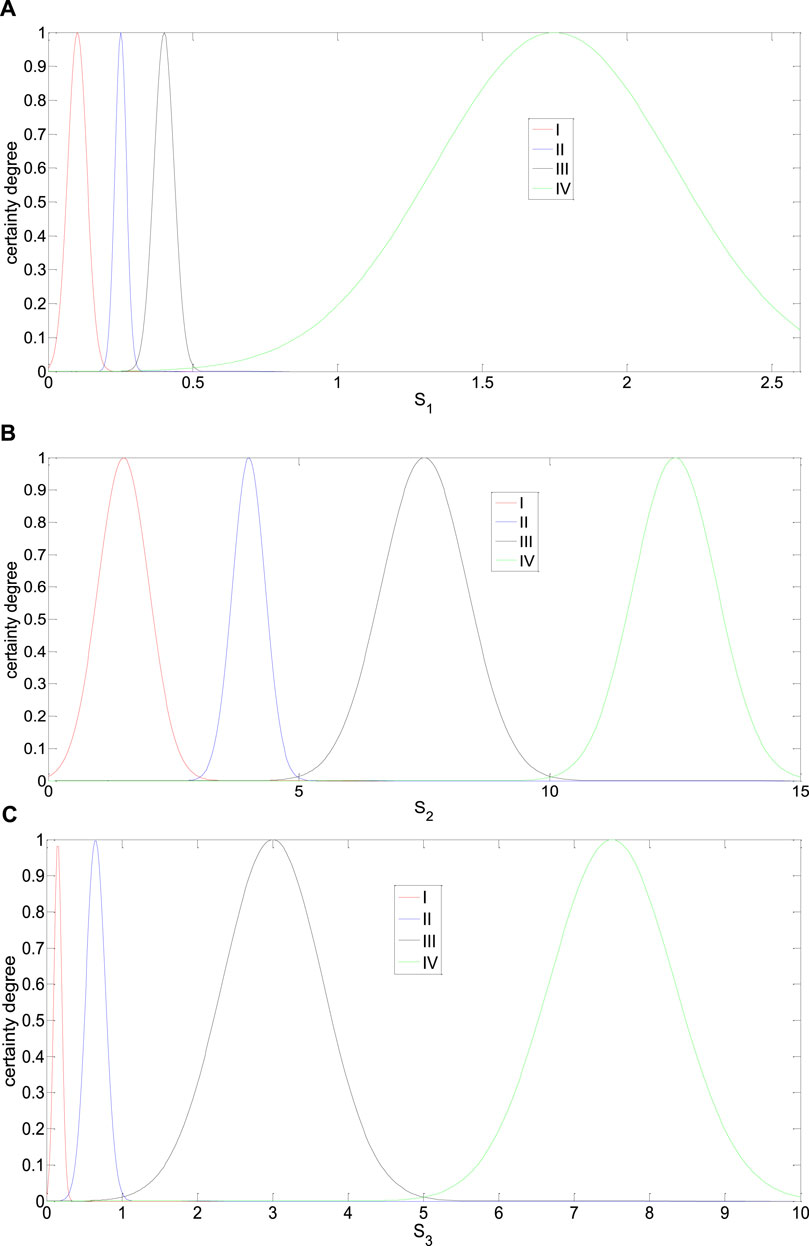
FIGURE 4. Cloud of each assessment index: (A) The width of fracture S1 (B) The length of fracture S2 (C) The depth of fracture S3.
The game theory combination weighting-normal cloud model is applied to evaluate the concrete dam fractures. The assessment results are depicted in Table 4. The hazard grade of the concrete dam fracture from Nos. 1–10 samples differ. The hazard level of concrete dam fractures at Nos. 1, 2, 4, 7, 8, and 9 samples is III and at Nos. 3s and 5 samples is I, and the remaining is I. Thus, the hazard level of the concrete dam fracture in most samples is significant, accounting for 60%. The remaining samples are light or common, accounting for 40%. So, necessary consolidation measurements should be taken for the Nos. 1, 2, 4, 7, 8, and 9 samples to prevent the concrete dam hazards. For example, grouting cracks could be performed. The other samples are considered safe.
The comparative results of the assessment model in Figure 5 indicate that the proposed method is consistent with the investigations for 10 different samples. Its accuracy reaches 100%, greater than the results from the Gray clustering method (80%) (LIANG et al., 2020). Therefore, estimating concrete dam fractures using the game theory combination weighting-normal cloud model is feasible. The proposed approach provides additional details for assessing concrete dam fractures. For example, the fracture length for the No. 5 sample is 11.5, belonging to level IV based on data in Table 2. In addition, the reliability distributions of the other indicators obtained using the proposed model belong to level III, indicating that the hazard level probability of the No. 5 sample at level III is greater than levels I, II, and IV. As a result, the hazard grade of the No. 5 sample is level III. Its hazard level is more likely to be level III than that of the No. 2 sample as the certain degree (0.3747) for level III is greater than the No. 2 sample (0.326). The results obtained using the proposed model accurately demonstrate the hazard level of concrete dam fractures and further determine the risk grade rankings for different samples at the same level.
5 Results and discussions
In comparison with the other traditional models, the fuzziness and randomness of evaluating the index are considered for the suggested model, and interval-oriented evaluation criteria are adopted. So, the suggested model improves the reliability of the assessment process and enhances the predictive accuracy of assessment results. So, in the future, it will have great application prospects in civil engineering.
However, some shortcomings still exist, for example, great calculative load and the neglected correlation among the indexes; these insufficiencies limit the development of the suggested method, but they still provide a new perspective for the hazard-level assessments of concrete dam fractures.
6 Conclusion
Considering the width (S1), length (S2), and depth (S3) of fractures establishes a new evaluation method to assess the hazard level of concrete dam fractures based on the game theory combination weighting-normal cloud model. The weight coefficients for three different assessment indexes are first determined based on game theory combination weighting. Then, the certainty degrees for different indexes are calculated using the entropy normal cloud method. Finally, the comprehensive degree of concrete dam fractures is determined, and the hazard level is judged.
The proposed method assessed the hazard level of concrete dam fractures. The results obtained by the proposed method are consistent with actual investigations for 10 different samples. The method’s accuracy reached 100%, which is greater than the results from the Gray clustering method (80%). The results give various hazard grades for the concrete dam fractures from Nos. 1–10 samples. The hazard level of concrete dam fracture at Nos. 1, 2, 4, 7, 8, and 9 samples is III, Nos. 3 and 5 samples is I, and the remaining is I. Thus, the hazard level of concrete dam fractures at most samples is significant, accounting for 60%. The remaining samples are considered light or common, accounting for 40%. So, the necessary consolidation measurements should be taken for Nos. 1, 2, 4, 7, 8, and 9 samples to reduce concrete dam risks. In addition, the reliability distributions of the other indicators obtained using the proposed model belong to level III, indicating that the hazard level probability of the No. 5 sample at level III is greater than levels I, II, and IV. The hazard grade of the No. 5 sample is level III, and its hazard level is more likely to be level III than that of the No. 2 sample as the certain degree (0.3747) for level III is greater than the No. 2 sample (0.326).
In total, the results from the proposed model accurately predict the hazard levels of concrete dam fractures and further determine the hazard grade ranking for different samples at the same level. The suggested method provides a new thought for the future of the hazard level of concrete dam fractures.
Data availability statement
The raw data supporting the conclusion of this article will be made available by the authors, without undue reservation.
Author contributions
W-WL: Data curation, Investigation, Writing–original draft. X-BG: Funding acquisition, Methodology, Writing–original draft. CY: Conceptualization, Supervision, Writing–review and editing. CZ: Formal Analysis, Validation, Writing–review and editing.
Funding
The author(s) declare financial support was received for the research, authorship, and/or publication of this article. This work is supported by the Opening Project of Sichuan Province University Key Laboratory of Bridge Non-destruction Detecting and Engineering Computing (2022QYJ02, 2022QYY02, and 2022QYJ02), Key scientific research projects of colleges and universities in Henan province (23B560019).
Conflict of interest
The authors declare that the research was conducted in the absence of any commercial or financial relationships that could be construed as a potential conflict of interest.
Publisher’s note
All claims expressed in this article are solely those of the authors and do not necessarily represent those of their affiliated organizations, or those of the publisher, the editors and the reviewers. Any product that may be evaluated in this article, or claim that may be made by its manufacturer, is not guaranteed or endorsed by the publisher.
References
B Zhang, L., Wang, M. W., and Li., B. (2018). Pavement performance evaluation model based on intuitionistic fuzzy sets and TOPSIS decision theory. J. Hefei Univ. Technol. 41 (7), 934–938.
Chen, J. W., and Zhou, X. P. (2019). The enhanced extended finite element method for the propagation of complex branched cracks. Eng. Analysis Bound. Elem. 104, 46–62. doi:10.1016/j.enganabound.2019.03.028
Gu, X. B., Ma, Y., Wu, Q. H., Ji, X. J., and Bai, H. (2021a). The risk assessment of landslide hazards in Shiwangmiao based on intuitionistic fuzzy sets-Topsis model. Nat. Hazards 111, 283–303. doi:10.1007/s11069-021-05053-5
Gu, X. B., Shao, J. L., Wu, S. T., Wu, Q. H., and Bai, H. (2021b). The risk assessment of debris flow hazards in zhouqu based on the projection pursuit classification model. Geotechnical Geol. Eng. 8, 4–17.
Gu, X. B., Wang, L., and Wu, Q. H. (2022a). The risk assessment of debris flow in the duba river watershed using intuitionistic fuzzy sets: TOPSIS model. Math. Problems Eng. 2022, 1–12. Article ID 2031907. doi:10.1155/2022/2031907
Gu, X. B., Wang, L., and Wu, Q. H. (2022b). The risk assessment of debris flow in the duba river watershed using intuitionistic fuzzy sets: TOPSIS model. Math. Problems Eng. 2022, 12. Article ID 2031907. doi:10.1155/2022/2031907
Gu, X. B., and Wu, Q. H. (2016). The application of nonordinary, state-based peridynamic theory on the damage process of the Advances in Materials Science and Engineering rock-like materials. Math. Problems Eng. 3 (8), 1–9.
Gu, X. B., and Wu, Q. H. (2019). Seismic stability analysis of waterfront rock slopes using the modified pseudodynamic method. Geotech. Geol. Eng. 37 (3), 1743–1753. doi:10.1007/s10706-018-0718-1
Gu, X. B., Wu, Q. H., and Zhu, Y. H. (2019). The experimental investigation on the propagation process of crack for brittle rock similar material. Geotechnical Geol. Eng. 37 (6), 4731–4740. doi:10.1007/s10706-019-00934-w
Gu, X. B., Wu, S. T., Ji, X. J., and Zhu, Y. H. (2021c). The risk assessment of debris flow hazards in Banshanmen gully based on the entropy weight normal cloud method. Adv. Civ. Eng. 2021, 1–11. doi:10.1155/2021/8841310
GuWu, X.-B. Q.-H., and Ma, Y. (2022). Risk assessment of the rockburst intensity in a hydraulic tunnel using an intuitionistic fuzzy sets-TOPSIS model. Adv. Mater. Sci. Eng. 2022, 1–14. Article ID 4774978. doi:10.1155/2022/4774978
Klauer, S. G., Dingus, T. A., and Neale, V. L. (2012). l. The impact of driver inattention on near-crash/crash risk: analysis using the 100-car naturalistic driving study data. Washington: National Highway Traffic Safety.
Liang, J., Lan-ting, ZHOU, and Zhi-kun, L. I. U. (2020). Hazard assessment of concrete dam fracture based on the improved cloud-evidence theory. J. Shandong Agric. Univ. ( Nat. Sci. Ed. 51 (3).
Lu, J., Fang, C., and Liuwei, W. U. (2012). The assessment on the crack danger of concrete. Dam Based Theory Var. Fuzzy 1 (2), 40–43. (in Chinese).
Xue-hui, F. (2015). Evaluation of dam safety based on cloud model and entropy weight method. Water Resour. Power 33 (11), 57–60. (in Chinese).
Zhang, J., and Yang, T. (2018). Study of a roof water inrush prediction model in shallow seam mining based on an analytic hierarchy process using a grey relational analysis method. Arab. J. Geosci. 11, 153. doi:10.1007/s12517-018-3498-2
Zhang, Z., Pang, K., Xu, L., Zou, Y., Yang, J., and Wang, C. (2023). The bond properties between UHPC and stone under different interface treatment methods. Constr. Build. Mater. 365, 130092. doi:10.1016/j.conbuildmat.2022.130092
Zhang, S., Dai, L., and Xiaohu, YUAN (2022). Fuzzy comprehensive prediction model of rock burst disaster in deep underground engineering. J. Luoyang Inst. Sci. Technol. 32 (3), 17–21.
Zhao, Y., Du, C., Bi, J., and Chaolin, W. (2021). Experimental investigation of triaxial compression and permeability of gritstone in geothermal environment. Bull. Eng. Geol. Environ. 80, 6971–6988. doi:10.1007/s10064-021-02370-8
Zhao, Y., and Liu, X. L. (2005). Application of ANN to risk assessment on debris flow. J. Geol. Hazards Environ. Preserv. 16 (2), 135–138.
Zhou, X. P., Bi, J., and Qian, Q. H. (2015). Numerical simulation of crack growth and coalescence in rock-like materials containing multiple pre-existing flaws. Rock Mech. Rock Eng. 48 (3), 1097–1114. doi:10.1007/s00603-014-0627-4
Zhou, X.-P., En-Ming, X., Yang, H.-Q., and Qi-Hu, Q. (2012). Different crack sizes analyzed for surrounding rock mass around underground caverns in Jinping I hydropower station. Theor. Appl. Fract. Mech. 57 (1), 19–30. doi:10.1016/j.tafmec.2011.12.004
Zhou, X. P., Gu, X. B., and Qian, Q. H. (2016). Seismic bearing capacity of shallow foundations resting on rock masses subjected to seismic loads. KSCE J. Civ. Eng. 20 (1), 216–228. doi:10.1007/s12205-015-0283-6
Zhou, X. P., Zhang, Y. X., Ha, Q. L., and Zhu, K. S. (2008). Micromechanical modelling of the complete stress-strain relationship for crack weakened rock subjected to compressive loading. Rock Mech. Rock Eng. 41 (5), 747–769. doi:10.1007/s00603-007-0130-2
Zhou, R., Wei, Z.-ying, Zhang, Y.-bin, and Shua, ZHANG (2017). A prediction of reference crop evapotranspiration based on generalized regression neural network and particle swarm optimization algorithm. China Rural Water Hydropower 6, 1–7.
Keywords: level evaluation, concrete dam fracture, game theory, combination weighting method, normal cloud model
Citation: Li W-W, Gu X-B, Yang C and Zhao C (2024) Level evaluation of concrete dam fractures based on game theory combination weighting-normal cloud model. Front. Mater. 11:1344760. doi: 10.3389/fmats.2024.1344760
Received: 26 November 2023; Accepted: 19 January 2024;
Published: 13 February 2024.
Edited by:
Zhongya Zhang, Chongqing Jiaotong University, ChinaCopyright © 2024 Li, Gu, Yang and Zhao. This is an open-access article distributed under the terms of the Creative Commons Attribution License (CC BY). The use, distribution or reproduction in other forums is permitted, provided the original author(s) and the copyright owner(s) are credited and that the original publication in this journal is cited, in accordance with accepted academic practice. No use, distribution or reproduction is permitted which does not comply with these terms.
*Correspondence: Xin-Bao Gu, MTU4MjM0MDU5NTJAMTYzLmNvbQ==
 Wei-Wei Li
Wei-Wei Li Xin-Bao Gu
Xin-Bao Gu Chao Yang3
Chao Yang3